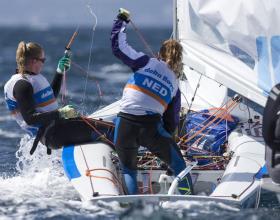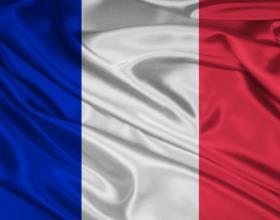Diabo News
19 nov. 2004
TanzaCat 2004
Looking back on a tropical sailing adventure
Catamaran sailing goes with adventure, so nine Dutch teams packed their multihulls for Tanzania. Time for a catamaran safari! We arrived on October 19th in Dar es Salaam, only one day after the container got there. My job was to join the group on this two-week trip and to write an article about it for Nautique, a Dutch Yachting magazine.
TanzaCat and Zanzibar
We started with TanzaCat itself, a three-day African regatta in the Msasani bay. Fifty-four teams sailed nine races with various conditions. Especially the competition between the South-African and Dutch F18-teams was close, but the South-Africans claimed the first two positions. After one day off, we sailed in seven hours to Zanzibar. It was only 25 miles, but the wind died completely. Just before sunset, we arrived at Kimzikazi. A beautiful white beach, surrounded by palm trees. Local boys helped us to carry the catamarans over the coral reefs. If there is a paradise, this is it! What a fantastic place to be. We stayed on the other side of the island, where the most gorgeous beaches of the Indian Ocean are. It was high moon, which made sand look like snow. Some locals completed the atmosphere with playing reggae music. We spent one more day on Zanzibar and sailed back to the Dar es Salaam Yacht Club.
Sinda Island
The second sailing trip was to Sinda Island, another pearl of the Indian Ocean. After a break we continued to Mbuja Island, where we spent the night. The organization had taken care of dinner, but hudge crabs scared the people, who were waiting for food. Soon, the monsters were used as fun tools... ‘put your feet in the air’. Looking for an outdoor toilet, was like a safari on the beach. Crabs and shells crawled everywhere! We spent the evening around a fire, singing songs with three guitar-players. Others were watching the falling stars, hoping their wishes would come true.
Selous National Game Resort
After all the sailing, we took the airplane to Selous National Game Resort for a three-day safari. The total surface of this national park is as big as Belgium and the Netherlands together, but only a third is open to tourists. At the end of the afternoon, we arrived in the Rufiji River Camp. A beautiful location with a great view on the river with all its threatening inhabitants. We started with a boat safari and saw many crocodiles and hippo’s. Next morning, we left the camp by jeep and it felt like we were entering a zoo. Giraffes were watching us from everywhere. They are very curious. We spotted the area continuously and we saw lions, impala’s, gnoe’s, elephants, zebra’s and many other animals. I was impressed by the scenery and the fact that I was just a visitor of this (to me) unknown world. On the last day, we did a safari by walking. After several hours and seeing only one impala, it happened that we were lost. The guides did not bring a compass, so we could help them out with our sailing watches. We thought so, but they did not believe us! One of us brought a flair, so a guide climbed up the tree. Sitting in the middle of branches and leaves, he let off the flair. For seconds, the air was red. They checked on the walkie-talkie, but none of the searching jeep-drivers had seen it, so the only bullet was fired... After six hours of walking with only half a liter of water, we found the two jeeps! Our adventure was complete!
The article (in Dutch) will be published in the January/February issue of Nautique. If you are interested in an article on the whole trip or only a part of it, please contact me. Professional photographer Rutger Geerling (www.fotograferen.net) did a great job on the photographic work.
TanzaCat and Zanzibar
We started with TanzaCat itself, a three-day African regatta in the Msasani bay. Fifty-four teams sailed nine races with various conditions. Especially the competition between the South-African and Dutch F18-teams was close, but the South-Africans claimed the first two positions. After one day off, we sailed in seven hours to Zanzibar. It was only 25 miles, but the wind died completely. Just before sunset, we arrived at Kimzikazi. A beautiful white beach, surrounded by palm trees. Local boys helped us to carry the catamarans over the coral reefs. If there is a paradise, this is it! What a fantastic place to be. We stayed on the other side of the island, where the most gorgeous beaches of the Indian Ocean are. It was high moon, which made sand look like snow. Some locals completed the atmosphere with playing reggae music. We spent one more day on Zanzibar and sailed back to the Dar es Salaam Yacht Club.
Sinda Island
The second sailing trip was to Sinda Island, another pearl of the Indian Ocean. After a break we continued to Mbuja Island, where we spent the night. The organization had taken care of dinner, but hudge crabs scared the people, who were waiting for food. Soon, the monsters were used as fun tools... ‘put your feet in the air’. Looking for an outdoor toilet, was like a safari on the beach. Crabs and shells crawled everywhere! We spent the evening around a fire, singing songs with three guitar-players. Others were watching the falling stars, hoping their wishes would come true.
Selous National Game Resort
After all the sailing, we took the airplane to Selous National Game Resort for a three-day safari. The total surface of this national park is as big as Belgium and the Netherlands together, but only a third is open to tourists. At the end of the afternoon, we arrived in the Rufiji River Camp. A beautiful location with a great view on the river with all its threatening inhabitants. We started with a boat safari and saw many crocodiles and hippo’s. Next morning, we left the camp by jeep and it felt like we were entering a zoo. Giraffes were watching us from everywhere. They are very curious. We spotted the area continuously and we saw lions, impala’s, gnoe’s, elephants, zebra’s and many other animals. I was impressed by the scenery and the fact that I was just a visitor of this (to me) unknown world. On the last day, we did a safari by walking. After several hours and seeing only one impala, it happened that we were lost. The guides did not bring a compass, so we could help them out with our sailing watches. We thought so, but they did not believe us! One of us brought a flair, so a guide climbed up the tree. Sitting in the middle of branches and leaves, he let off the flair. For seconds, the air was red. They checked on the walkie-talkie, but none of the searching jeep-drivers had seen it, so the only bullet was fired... After six hours of walking with only half a liter of water, we found the two jeeps! Our adventure was complete!
The article (in Dutch) will be published in the January/February issue of Nautique. If you are interested in an article on the whole trip or only a part of it, please contact me. Professional photographer Rutger Geerling (www.fotograferen.net) did a great job on the photographic work.
More news
Nederlands
English
- 1 articles (EN)
- 1 articles (EN)
- 1 articles (EN)
- 2 articles (EN)
- 1 articles (EN)
- 4 articles (EN)
- 1 artikelen (NL)
- 10 articles (EN)
- 3 artikelen (NL)
- 8 articles (EN)
- 9 artikelen (NL)
- 14 articles (EN)
- 24 artikelen (NL)
- 5 articles (EN)




